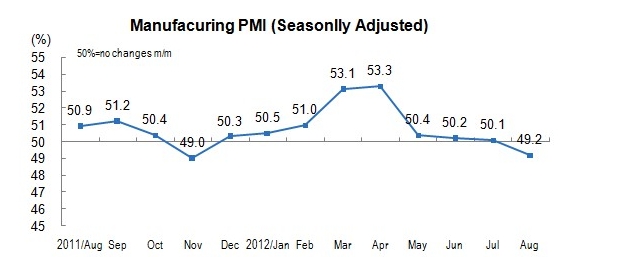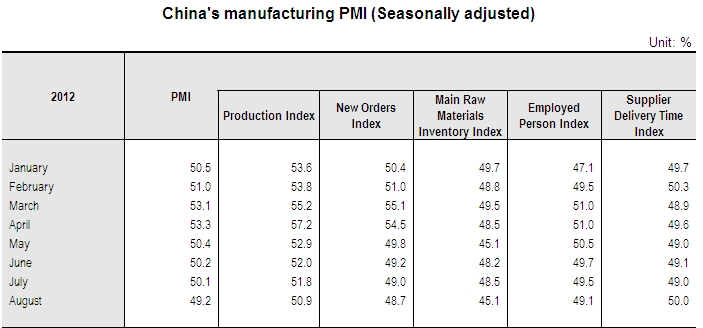In August, China's manufacturing purchasing managers index (PMI) was 49.2 percent, down by 0.9 percentage points month-on-month. In view of the sizes of enterprises, the PMI of large-sized enterprises was 49.1 percent, decreased 1.2 percentage points month-on-month, that of medium-sized enterprises was 49.9 percent, decreased 0.3 percentage points month-on-month, that of small-sized enterprises was 47.7 percent, decreased 0.4 percentage points month-on-month.

In August, among the five sub-indices composing PMI, one sub-index increased, while that of the other four sub-indices decreased.
Production index was above the threshold, which was 50.9 percent, decreased 0.9 percentage points month-on-month, indicating that manufacturing production was still expanding, while the growth slowed down. In view of different industries, the production outputs of tobacco manufacturing, foods, liquor, beverages and fine tea manufacturing, computer communications, electronic equipment and instrumentation manufacturing kept steady growth; the production indices of special equipment manufacturing, automobile manufacturing, ferrous metal mining and processing, textile manufacturing, positioned below the threshold, and the production outputs showed a falling down trend.
In August, the new orders index was 48.7 percent, fell by 0.3 percentage points month-on-month. In view of different industries, the new orders indices of foods, liquor, beverages and fine tea manufacturing, computer communications, electronic equipment and instrumentation manufacturing, tobacco manufacturing and agro-food processing industry, still stayed above the threshold, and market demand continued to grow. The new orders indices of special equipment manufacturing, ferrous metal mining and processing, textile industry, fabricated metal products manufacturing, and manufacturing of general equipment were below the threshold, the volume of product orders of enterprises from customers continued to decrease. The survey results showed that foreign new orders index which reflects the situation of foreign trade of manufacturing was 46.6 percent, remained at the same level over the last month; the import index was 47.0 percent, increased 2.0 percentage points month-on-month.
Main raw materials inventory index was 45.1 percent, down by 3.4 percentage points month-on-month, staying below the threshold, which indicating that manufacturing inventories of raw materials fell faster. In view of different industries, the raw material inventories of tobacco manufacturing, foods, liquor, beverages and fine tea manufacturing continued to increase; the main raw materials inventory indices of fabricated metal products manufacturing, textile industry, ferrous metal mining and processing, textile wearing apparel manufacturing, manufacturing of general equipment and special equipment manufacturing were below the threshold, with a significant decline in raw material inventories.
Employed person index was 49.1 percent, decreased 0.4 percentage points month-on-month, which indicating that with the impact of the poor condition of manufacturing economic, the demand growth of manufacturing employment has reduced. In view of different industries, the employed person indices of railways, ship, aerospace and other transportation equipment manufacturing, foods, liquor, beverages and fine tea manufacturing, processing and coking of petroleum, tobacco manufacturing, computer communications, electronic equipment and instrumentation manufacturing were above the threshold, and demand for employed person increased; that of fabricated metal products manufacturing, textile industry, automobile manufacturing, textile wearing apparel manufacturing, processing of timber and furniture manufacturing were below the threshold, and demand for employed person decreased.
Supplier delivery time index was 50.0 percent, 1.0 percentage points higher month-on-month, positioned at the threshold, which indicated that the delivery time of manufacturing suppliers of raw materials was not very different with that of the previous month.
The main raw material purchase price index was 46.1 percent, up by 5.1 percentage points month-on-month, positioned below the threshold for 4 consecutive months, which indicating that the manufacturing main raw material purchase price continued to decline, and the cost of production decreased. In view of different industries, the main raw material purchase price indices of agro-food processing industry, chemical fiber manufacturing, rubber and plastic manufacturing, tobacco manufacturing and pharmaceutical manufacturing were above the threshold, and the procurement costs of enterprises increased; that of ferrous metal mining and processing, fabricated metal products manufacturing, special equipment manufacturing, paper and printing industry,cultural, educational, sporting goods manufacturing, manufacturing of general equipment were below the threshold, and the raw material procurement costs of enterprises decrease at varying degrees.
In addition, the finished goods inventory index was 48.2 percent, up by 0.2 percentage points month-on-month, continuing to stay below the threshold for 2 consecutive months, which indicating that the finished goods inventory of manufacturing continued to decrease.

Annotations:
1. Explanatory Notes
Purchasing Managers Index (PMI) is an index summarized and compiled through the results of the monthly survey of enterprises purchasing managers. It covers every links of the enterprises, including purchasing, production, logistics, and so on. It is one of the leading indices which was commonly adopted by international society to monitor the macroeconomic trends, and played an important role in forecasting and monitoring. The threshold of PMI is usually using 50 percent as the cut-off point for economic performance. If PMI above 50 percent, it reflects the manufacturing economy is expanding; if less than 50 percent, it reflects the manufacturing economy is in recession.
2.Statistical Coverage
The survey involves 31 divisions of manufacturing sector in the 'Industrial Classification for National Economic Activities' (GB/T4754-2011), and totally 820 sampling enterprises are selected and surveyed countrywide.
3. Survey Methods
PPS (Probability Proportional to Size) sampling method was adopted in manufacturing purchasing managers'survey. Using the divisions of the manufacturing sector as the selecting strata, the sample size of each division is proportional to its proportion of the value-added of the division to the total value-added of the manufacturing sector. Within the stratum, the samples are selected according to the probabilities proportional to their principal business revenues of the enterprises.
The survey was conducted monthly through Online Reporting System of NBS by sending survey questionnaires to the purchasing managers of the selected enterprises.
4. Calculation Methods
The questionnaire of manufacturing purchasing managers survey covers 11 questions related to production, new orders, export orders, existing orders, finished goods inventory, purchase, import, purchase prices, raw materials, inventory, employees, suppliers, delivery time, and etc.. Diffusion index was calculated for each question, i.e. percentage of positive answers in number of enterprises plus half of the percentage in the same answers.
PMI is a composite index, which was calculated according to five diffusion indices (group indices) and their weights. 5 group indices and their weights are determined in accordance with their leading impact on the economy. Specifically, new orders index weighted 30 percent; production index weighted 25 percent; employees index weighted 20 percent; supplier delivery time index weighted 15 percent; raw materials inventory index weighted 10 percent. Of which, the supplier delivery time index is a converse index, and contrary calculation is needed when combines it into PMI.
5. Seasonal adjustment
The purchasing managers'survey is a monthly survey, the data of the survey fluctuates very much for the influences of seasonal factors. The released PMI composite index and sub-indices are seasonally adjusted data.





